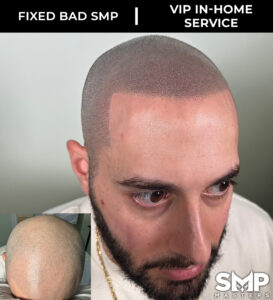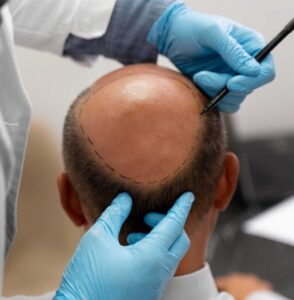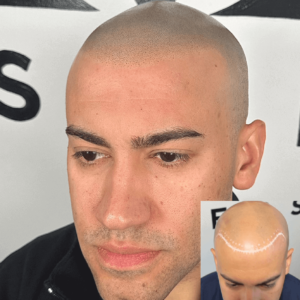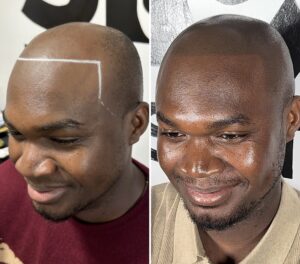Beard Hair Transplant is your gateway to achieving the coveted look of a full, thick beard, the hallmark of masculine aesthetics. No longer just a secret among the elite, this procedure has become a beacon of hope for many facing patchiness or thinning that undermines their facial hair’s potential. By transplanting your own hair to the beard area, it promises to fill in gaps and enhance density, offering a permanent solution that grows naturally over time. With advanced techniques and personalized care, the dream of a robust beard is not just a possibility—it’s a reality within reach.
Understanding Beard Hair Transplant
Beard hair transplant is a cosmetic procedure aimed at enhancing the density and appearance of facial hair for men who struggle with patchy or incomplete beard growth. This procedure involves transferring hair follicles from a donor site, typically the back of the scalp, to the beard area.

Procedure and Techniques
The transplant involves meticulous techniques such as Follicular Unit Extraction (FUE) or Follicular Unit Transplantation (FUT). In FUE, individual follicles are harvested and then implanted into small incisions made in the facial area, while FUT involves removing a strip of skin from which follicles are extracted.
Candidate Suitability
Ideal candidates are those with healthy growth at the donor site and realistic expectations. Prior to surgery, a consultation is necessary to discuss the desired outcome and evaluate the facial structure.
Post-Operative Care and Results
Post-operative care is crucial for successful healing and optimal results. This includes avoiding strenuous activities and following a prescribed skincare routine. The results of a beard transplant are typically visible after several months, as the transplanted hair adapts to its new location.
Beard hair transplant offers a permanent solution for men wishing to enhance their facial hair density, significantly boosting self-confidence and facial aesthetics.
Benefits of Opting for a Beard Hair Transplant
Beard hair transplants have become an increasingly popular solution for men looking to enhance or restore their facial hair. This procedure not only helps in achieving a fuller, more defined beard but also offers several other benefits. Below, we will explore the various advantages of opting for a beard hair transplant.
Improved Appearance and Confidence
- Aesthetic Enhancement:
One of the primary reasons many choose to undergo a beard hair transplant is the aesthetic improvement it offers. A full, well-shaped beard can define facial features more distinctly, contributing to a more mature and robust appearance. This cosmetic enhancement can significantly impact personal and professional interactions, where a well-groomed appearance might play a crucial role. - Boosted Self-Esteem:
With the improvement in physical appearance, recipients of beard transplants often experience a significant boost in confidence. This increased self-esteem can positively affect various aspects of life, including social interactions and professional opportunities.
Customizable and Natural Results
- Tailored to Individual Needs:
Beard hair transplants are highly customizable. During the procedure, the surgeon can adjust the density and shape of the beard according to the patient’s desires and facial structure, ensuring that the results look natural and suit the individual’s face. - Utilization of Own Hair:
The transplant process typically involves using hair from the patient’s scalp, which helps in achieving a look that is both natural and harmonious with the rest of the hair. This compatibility reduces the risk of the body rejecting the transplant and ensures the texture and color match the existing facial hair.
Permanent Solution
Long-Term Results
Unlike temporary solutions such as makeup or hormonal treatments, a beard hair transplant offers a permanent enhancement of facial hair. Once the transplanted hair follicles establish themselves, they continue to grow naturally for years. This permanence eliminates the need for ongoing treatments or constant maintenance.
Low Maintenance
After a successful transplant and the initial healing period, the new beard requires no more upkeep than the usual grooming practices. This simplicity is a significant benefit for those who want a good-looking beard without extra effort or special products.

The Procedure Step by Step
Understanding the procedure of any medical or surgical intervention is crucial for those considering undergoing the process. Here, we’ll detail a typical step-by-step breakdown of a general procedure, which can apply to various types of surgeries or medical treatments. This guide aims to provide clarity and help set realistic expectations for patients.
Initial Consultation
- Assessment and Discussion: The first step in any procedure is an initial consultation with a professional. During this meeting, the practitioner assesses the patient’s needs, discusses their medical history, and addresses any concerns. This step is vital for establishing a clear understanding of the patient’s expectations and the realistic outcomes of the procedure.
- Planning: Based on the initial assessment, the professional will outline a personalized plan. This plan includes details about the procedure itself, the preparation required, and what the recovery period will entail. The planning phase ensures that both the patient and the practitioner are on the same page and ready to proceed.
Preparation
- Pre-Procedure Instructions: Patients will receive specific instructions to prepare for the procedure, which may include dietary restrictions, medication adjustments, or pre-treatment tests. Following these instructions is essential for ensuring the safety and success of the procedure.
- Setting a Date: Once the patient is ready and all preliminary tests and preparations are complete, a date for the procedure is set. Scheduling considerations include the patient’s availability, the necessity of any pre-procedure preparations, and the availability of the facility and staff.
The Procedure
- Anesthesia: Most significant procedures involve some form of anesthesia, whether local, regional, or general. The type of anesthesia used will depend on the nature of the procedure and the patient’s health profile
- Performing the Procedure: This is the central part of the process where the actual surgical or medical intervention takes place. The specifics will vary widely depending on the nature of the procedure but generally follow the planned method discussed during the initial consultations.
Immediate Post-Procedure Care
- Monitoring: Immediately following the procedure, patients are typically monitored in a recovery area, especially if anesthesia was involved. Monitoring aims to ensure that there are no immediate complications and that the patient begins to recover safely.
- Initial Recovery: Before leaving the facility, patients are usually given post-procedure instructions, which may include care for any incisions or wounds, signs of complications to watch for, and restrictions on activity.
Follow-Up Care
- Post-Procedure Visits: Follow-up visits are crucial to monitor the patient’s healing and the success of the procedure. These appointments allow the practitioner to assess recovery, address any concerns, and make adjustments to the recovery plan as needed.
- Long-Term Care and Maintenance: Depending on the procedure, some long-term care or maintenance might be necessary. This could involve additional treatments, lifestyle adjustments, or further surgeries.
Potential Risks and How to Mitigate Them
Any medical or surgical procedure carries inherent risks, and understanding these is crucial for both preparation and decision-making. This guide outlines common potential risks associated with various procedures and offers strategies for mitigating these risks to ensure the safest possible outcomes.
Understanding the Risks
- Common Risks: Most procedures, particularly surgical interventions, include risks such as infection, bleeding, adverse reactions to anesthesia, and complications related to pre-existing conditions. Each type of procedure comes with its own set of specific risks, which should be discussed in detail with a healthcare provider.
- Serious Complications: While less common, serious complications can occur and may have significant consequences. These include severe allergic reactions, long-term side effects, organ damage, and in rare cases, death. Understanding these risks is essential for a fully informed consent.
Strategies for Mitigation
- Thorough Consultation and Planning: One of the most effective ways to mitigate risks is through a thorough initial consultation. During this phase, the healthcare provider should evaluate the patient’s medical history and any pre-existing conditions that might increase the risk of complications. Detailed planning can then be tailored to minimize these risks
- Choosing the Right Provider: Selecting an experienced and qualified healthcare provider is crucial. Ensure that the provider has a track record of successfully performing the procedure and is licensed in the relevant medical field. Also, consider the facility where the procedure will be conducted; it should be well-equipped and accredited.
Pre-Procedure Preparation
- Health Optimization: Patients can take several steps to optimize their health before undergoing a procedure. This might include following a healthy diet, getting adequate sleep, managing stress, and following specific medical advice related to managing chronic conditions.
- Following Pre-Procedure Instructions: Adhering to the pre-procedure instructions provided by the healthcare team is vital. These might include fasting, adjusting current medications, or preparing physically and mentally for the procedure.
During the Procedure
- Anesthesia Safety: Work closely with the anesthesia team to discuss any previous reactions to anesthesia and any allergies. Anesthesia should always be administered by a certified anesthesiologist or a nurse anesthetist under strict guidelines.
- Sterile Techniques: Ensure that the procedure is performed under sterile conditions to prevent infections. The medical team should follow all protocols related to sterilization and use of disposable gloves, gowns, and tools as appropriate.
Post-Procedure Care
- Post-Procedure Visits: Follow-up visits are crucial to monitor the patient’s healing and the success of the procedure. These appointments allow the practitioner to assess recovery, address any concerns, and make adjustments to the recovery plan as needed.
- Long-Term Care and Maintenance: Depending on the procedure, some long-term care or maintenance might be necessary. This could involve additional treatments, lifestyle adjustments, or further surgeries.
Proven Expertise in SMP
-
At SMP, our team of certified professionals has years of experience in perfecting the art of Scalp Micropigmentation. With an in-depth understanding of hairline design and pigment application, we ensure natural-looking results tailored to each client's unique needs and facial structure.
High Client Satisfaction
-
Our commitment at SMP is not just to meet, but to exceed client expectations. This is reflected in our high client satisfaction rates and the glowing testimonials we receive. We pride ourselves on transforming lives through enhanced aesthetics and boosted confidence.
Customized Treatment Plans
-
Each scalp is a new canvas, and every client at SMP receives a personalized treatment plan. We consider factors such as age, hair color, and degree of hair loss to create the most effective and visually appealing results.
Advanced Technology and Techniques
-
We utilize the latest SMP technology and cutting-edge techniques to ensure minimal discomfort and downtime. Our precise applications mimic natural hair follicles, providing a discreet and enduring solution to thinning hair.
Conclusion
The journey to a fuller, thicker beard, free from patches and thin areas, is no longer shrouded in mystery. Beard Hair Transplant has unveiled itself as a reliable and increasingly popular solution for those looking to enhance their facial hair. Whether you seek to bolster your confidence or simply to enjoy the aesthetic appeal of a lush beard, the advancements in hair transplant procedures offer a promising path. With the right care and an experienced surgeon, the secret to a fuller beard is at your fingertips.








